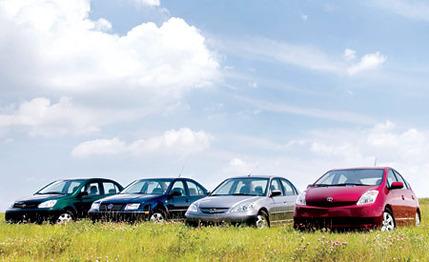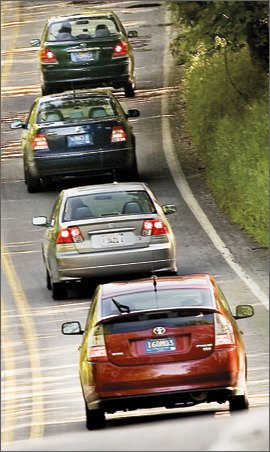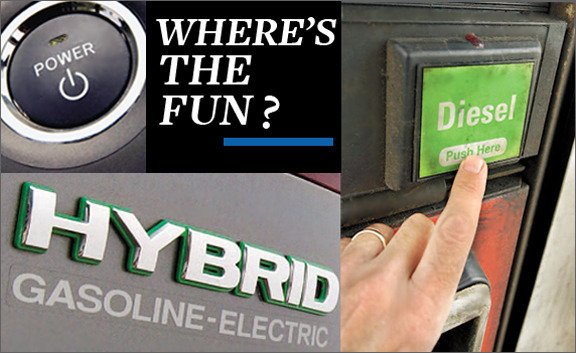 Comparison Tests
Comparison Tests
When gas prices bump the weather out of American conversations, as they have this spring, you know the popular press will spray out a billow of gas-mileage stories.
Just remember— your gas mileage may vary. This is the one salient detail you should take from all the verbiage, theirs and ours. Producing an accurate gas-mileage evaluation is so difficult that most folks don't think even the federal government can do it.
If You Want Big Mileage Numbers

The buzz today is about the miracle mileage makers called "hybrids." Wearing a Toyota Prius has become such a sought-after badge among the greenies that some dealers have been asking $5000 over the $21,290 sticker.
Does this make economic sense? Buy some other frugal car for 20 large—say it gets only 30 mpg of $2 gas instead of the Prius's 55 mpg (that's the EPA's combined city and highway number)—and that five grand premium on the price of the car applied to gas will take you 75,000 miles. The Prius will have been driven 165,000 miles by the time enough dollars are saved on gas to overcome that extra starting cost.
But so what. Let's agree that mileage is an emotional buy, just as pleasing to some as low 0-to-60 times are to others. Let's also stipulate that really big mileage numbers are a valid expression of high performance and can be just as compelling as acceleration if you hold your mind right.

The Frugalympics
This is the old idea of "What'll she do?" redirected toward saving gas. We've rounded up four different mileage makers to explore gas mileage in everyday driving.
For highway mileage we drove freeways across Michigan from Ann Arbor to Holland and back, 337 miles between fills. Traffic hustles along these days. We drove 75 to 80 mph where possible, at the upper range of flow.
For city we rolled up 107 miles around metro Ann Arbor on a perfect summer's day, delaying the start until after morning rush hour to ease our need for Rolaids. Speeds were sensible but, again, in the upper range of unimpeded traffic flow where space allowed.
For a suburban route, our quartet motored 135 miles over two-lane blacktops and through small villages in lower Michigan. When we had open road, we often topped 60 mph, but we stayed within 5 mph of the limit.
So much for the obvious tests. We engineers on staff like the esoteric stuff every chance we get. The editor-in-chief remembered a hasty trip he'd made one morning in an early Honda Insight Hybrid from Ann Arbor to DaimlerChrysler headquarters in Auburn Hills, north of Detroit at—well, let's just say we're talking felony speeds. The time was morning commuter hours, and he was shooting gaps in traffic, flat out to the upper reaches of the speedo, then slowing—full power then regen, again and again—for the 58-mile trip. What happened? Even with the full-power bursts that guzzle, relatively speaking, the battery charge held up very well.
In other words, regen really works. So this question: When driven hard, do hybrids suffer less fuel gobbling than other cars? One hundred miles at "arrest me" speeds on public roads is too much even for the hot bloods among us. So we squealed tires for 100 miles around Waterford Hills, a club road course north of Detroit.
So much for the testing. What cars? We identified three promising categories.
The One-Calorie Car
Traditionally, small cars—the bottom dwellers on the price and status ladder—got the best mileage. From the Henry J of the '50s to the VW Beetle and Rambler American of the '60s to the Honda Civic of the '70s (those darlings of the first oil embargo), the One-Calorie Car was the mpg leader.
To represent that "technology" in this comparison, we have a humble Toyota Echo, $13,975 worth of naked frugality.
Dr. Diesel's Dreamboat
Back in simpler times, diesel cars squeezed more mileage from a fuel that cost less. If you were willing to look for filling stations that were scarce, and had the patience for torpid acceleration, a diesel was the cents-per-mile champ.
Today diesels are prestigious in big pickups and mostly shunned in cars on American roads. Government standards are intolerant of diesel exhaust, and few automakers see much opportunity until after low-sulfur fuel arrives in 2006.
We hear of diesel's great popularity in Europe. Don't be misled. Those folks don't love diesels any more than we do. It's the fuel cost, stupid. Although diesel fuel prices in the U.S. have been well above gas prices over most of the past few decades (they happen to be lower now), many European countries have tax incentives for diesel fuel. As a result, in April 2004, diesel cost 41 percent less than gasoline in Poland, 34 percent less in Belgium, and 21 percent less in Germany and Italy. So of course diesel cars are popular where fuel is cheap. In the British Isles and Switzerland, where diesel fuel costs a shade more than gas, gasoline cars remain dominant.
Currently, Volkswagen is the leading diesel supplier in the U.S. Representing that choice in our Frugalympics is a VW Jetta GLS TDI powered by a 100-hp turbocharged four.
A Pair of Hybrids
Toyota and Honda take much different approaches to the idea of a hybrid car. The Toyota is Star Trekky-looking in any crowd, whereas the Honda blends to background among its Civic siblings. Think of the Prius as the Nerd's Solution—a unique, lightweight, super-roomy four-door body crammed with drive-by-wire power and braking and enough software to make Microsoft a little jealous. It's a "parallel" hybrid, which means it can run on its gas engine, or its electric battery, or some combination of both.
The Honda Civic Hybrid is a regular Civic four-door with an extra-thrifty four-cylinder engine supplemented by a wonderfully simple hybrid adapter that gives regenerative braking (recaptures energy into the battery on deceleration) and electric torque boost when needed for acceleration. It's a "series" hybrid incapable of moving as an electric car.
Neither of these hybrid approaches would have been possible before '90s sophistication in computer control and power-conversion electronics or, for that matter, recent battery technology.
Your Mileage May Vary
Before we get to the numbers, a few words about mileage tests. Never mind what some people say: EPA city and highway numbers come from tests executed to perfection. If you drive the test conditions, you'll get the test mileage. But tests, even our tests, are idealized in certain ways. We drove real cars on real roads in real traffic. So the results are real. That said, there were no short trips, no cold weather, no passengers or cargo to add weight.
Moreover, although we meticulously performed our refills, they covered relatively short distances. When adding less than three gallons, as we did a few times, a small error leads to a large deviation in mpg. To make matters worse, some cars are notoriously hard to fill precisely—the Prius may be the worst ever.
Mileage on the Highway
All four cars got more than 40 mpg, and the Prius hit 50. Amazingly, the One-Calorie Toyota Echo squeaked above its EPA highway number (39) to 41 mpg. The diesel, at 42 mpg, fell 2 mpg behind its EPA rating.
Regen, the big idea in hybrids, gives almost no benefit on the highway. You'll get a bit of recharge when you coast up behind slower traffic, but you should regard that as a smaller loss from going fast rather than a saving.
Still, the hybrids copped the top two places for solid reasons: They are engineered to be frugal even without the hybrid part. Their smaller, extra-efficient engines would be unacceptable performers to most drivers without the acceleration boost that's also baked into the hybrid package. They have special transmissions, tires, and low-drag aero tweaks, too. It all adds up.
Still, we find the 40-plus highway mileage in this test to be encouraging. Frugality is possible even at high road speeds.
Mileage in Town
The Prius again scored at the top with 52 mpg. Dr. Diesel, in last place at 33, was a bit of a surprise. We expected more. Diesels are at their best, relatively speaking, under light loads; they inject very little fuel and they have no throttling losses. Again, the One-Calorie Echo did superbly at 42 mpg.
We ran this test twice with consistent results, except for the Civic's. The Honda ran the first loop in the automatic temperature mode, the second in auto with the "econ" button pushed. Econ allows the engine to shut down at traffic lights. The results were profoundly different—40 mpg with the engine running all the time, 53 mpg when the engine could shut down in times of its own choosing. This is a bigger difference than we expected, but not, it turns out, beyond the expectations of fuel-economy engineers. Loss of air conditioning on stops was tolerable; it would be less so on the hotter days of high summer. Keep in mind, though, that this improvement is possible only in stop-and-go driving. If you manage to roll through every stop, you'll have a different result.
These four cars are by no means equal. The parsimonious Echo is a thinly upholstered box utterly lacking in spirit, smallest by far in dimensions, weight, and price. Our drivers dreaded taking their turns in the disjointed driving position. That said, the minimalist approach in which you eschew everything, including the several hundred pounds of technology needed to outfit a hybrid, still works reliably for mileage.
Mileage in Suburbia
This is a cycle lacking the predictable mileage killers of high speeds and frequent stops and starts (we obeyed all stop signs, of course). The two hybrids tied for top mileage at 54 mpg. Temperatures were in the 60s, and the sky was not cloudy all day. Nor was a discouraging word heard. But there was nothing artificial about conditions. Other cars with other drivers should achieve the same results.
Fast Forward at the Racetrack
All four entries achieved nearly the same result at the track, between 16 and 18 mpg, signifying very little, we think, except for the limits of regen. Today's technology defaults to regular brakes during high-energy braking, whether it's high g or high speeds. We should have remembered that track demands would exceed capability.
What Does It All Mean?
Some voices, even some staff engineers, want to say hybrids can't deliver on their EPA ratings; that hybrid technology games the system even though it may do so in good faith. That's the wrong take on the numbers, we think.
Instead, think of hybrids as "software" cars. They decide on their own when to start and stop the engine. The Prius can even move smartly with the fuel burner off. In fact, the Prius runs almost half of the EPA city test without the engine. That's a tremendous achievement.
But if your driving includes higher speeds and less time at stops, your mileage will come up well short of EPA city. On the other hand, if you have more low-'n'-slow, you will benefit more. Nobody, including software gurus, can predict where and how you will drive.
That said, the hybrids produced the best mileage here, and they delivered the most enjoyment per dollar.
Where's the Fun?
If you think driving a frugal car is right up there with tucking into a lunch of cottage cheese and oat hulls, yeah, that's one way to view it. But there's some slick machinery, too. Here's how to tell which is which, rated on a 0-to-100 scale: